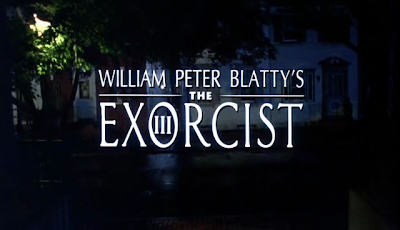For your consideration: I’m writing a spec script:
A Nightmare on Elm Street 2: Freddy’s Return. Click the sidebar poll to declare your interest. I thank you.
A Nightmare on Elm Street 2: Freddy’s Return. Click the sidebar poll to declare your interest. I thank you.
The Thing is no more a horror film than Invasion of the Body Snatchers 1956. The latter is a sci-fi classic. Whereas the former hasn’t achieved that status amongst critics it is beloved amongst the Horror Folk. As such there are those who contest it is a horror film. Here at Thrill Fiction the definition of horror is distinct: it is a movie with intent to scare – with the story structured around that intent. The Thing is a paranoid thriller within a sci-fi setting. More than 25 years after its theatrical release Thrill Fiction deems it classic sci-fi.
The Thing from another World 1951 doesn’t have such genre confusion. It is sci-fi. It is not a classic. The original Invasion of the Body Snatchers has a casting link to the 1978 remake; ie Kevin McCarthy’s thunderous cameo. The Fly 1958 starred Vincent Price. Both examples serve to connect those originals to the public consciousness. The Thing from another World has no enduring stars. It is largely forgotten in an industry that churns out 500+ motion pictures per annum.
There are plenty of critics, publications and Horror Folk who contend that The Thing is horror. Here at Thrill Fiction argument is conducted over fact not opinion. Therefore I’m happy to consider their point of view as far as this article is concerned however The Thing will never appear in my Best Horror Films list. As it is this post is dedicated to the kid Cody and everyone else who enjoys their horror - even if I may call it something else.
John Carpenter’s The Thing
The 12 men of the United States National Science Institute Section 4 entertain themselves by playing table tennis, repetitively watching videotapes of game shows, drinking and pot smoking. These are men of a certain tone. They are working class/blue collar. They are one step above oil drillers - the antithesis of lab coats. Not a one has backstory. They identify themselves through deeds not words. These are men who prefer to act as opposed to ruminate; Doc makes the snap decision to investigate the Norwegian’s camp despite bad weather.
Garry shoots a Norwegian dead.
Anyone who’s ever worked in an all male environment or attended an all boy’s school knows the inherent tensions of the pecking order. There’s always a power struggle to be top dog. Not everyone’s involved. It only takes two. Ergo there’s forever a coup d’état in waiting. MacReady (Kurt Russell), Childs and Clark are the big dogs. Blair and Doc are the old dogs. Garry is an old dog with a gun. Palmer, Windows and Nauls are the baby dogs. Norris, Bennings and Fuchs are the passive dogs.
The respective plots mirror each other and converge at certain points; the discovery of a spaceship then return to base with the alien/thing, the chest bursting scene coupled with the blood testing scene. Even the story parameters are similar; the truckers-in-space concept becomes truckers-in-Antarctica. It is on terra firma that Carpenter expands the premise. By expunging women he removes all political correctness/distractions/love sub-plots. He further expands the premise by removing a chain of command; the research team will have to figure it out as the Thing takes them out one by one. Remove the Thing from Carpenter’s film and replace it with HR Giger’s alien and there would be no need for script revision. The Thing – much more so than Aliens 1986 – is the thematic sequel to Ridley Scott’s film.
John Carpenter’s purple patch began in 1976 with his sophomore effort Assault on Precinct 13. In 1981 he directed Escape from New York starring Kurt Russell. The purple patch ended in 1982 with The Thing which also starred Kurt Russell. Carpenter and Russell have worked together before and after the purple days but it is the New York/Thing double whammy that defines their partnership. The Thing is their best work together.
Russell leads a cast of character actors that perform as part of a whole. The script is tighter than Alien – indeed the writing is so focussed story and plot is barely distinguishable. There are no dialogue scenes to establish character and/or dynamics. In this film character unfolds with plot. This is a film of action, reaction and interaction; Blair’s destruction of the choppers and radio. The decision to keep him imprisoned despite the threat of the Thing. The palace coup over the vandalised blood samples.
When Mac accuses Childs et al of being a “lynching party” Carpenter is being overt. Whenever he uses African-American actors as hero (Austin Stoker in Assault on Precinct 13 1976) or villain (Isaac Hayes in Escape from New York) he does so without prejudice. There are no racist undertones or slurs in his movies. He’s in the minority.
With sparse dialogue and less exposition the story is told through action and acting. The performances are fine tuned and tension laden. Every time the Thing succeeds in consuming a researcher it is of significant loss to the viewer. The set pieces are cinema as entertainment: The Thing attacking the dogs, Doc’s attempt to revive Norris, the blood test.
In The Bad and the Beautiful 1952 Kirk Douglas describes how to make Cat People 1942 with no budget: if you can’t afford a monster don’t create one. Allow the audience to run themselves wild with imagination of what’s in the shadows. It is the ethos of less-is-more. The Thing has an abundance of reveals in an orgy of special effects. (The reasons for this are described by Mark Kermode in the Google online Channel 4 documentary on Carpenter. To wit it’s because he could.) The final confrontation shows the Thing in its uninhibited gory. For dramatic effect it should have stayed hidden.
There are other faults. Plot wise why keep the dog? The Norwegians wanted to kill it yet the Americans don’t even quarantine it. Doc’s explanation of “stir crazy” isn't sufficient. The radio not working is cliché – nowadays it’s the cell phone. Yet the plot would have worked without that ploy. Windows should have made distress contact. It would have meant that a rescue team was on hand but waiting for the storm to abate. That would add tension on the level of hope and of global contamination. Then there is the pre credit scene of a spaceship landing on earth. Like the mirror opening of Invasion of the Body Snatchers 1978 it’s extemporaneous.
Apart from the dog these faults barely detract from the narrative. The legacy and influence of this film lives forever in cinema. There have been lackadaisical copycats: The Thaw 2009, Whiteout 2009. There has been homage: Trick r Treat 2009. If Alien is a better film then it’s because it has a better monster. If Halloween 1978 is a better film it’s because it is a different genre. The consensus is The Thing is better than the original. You don’t have to be a seer to predict it will be better than the 2011 prequel. This is the apotheosis of John Carpenter’s purple period and of his whole career. He will never be better.
If I was to accept this movie as horror it would rank #10 on my Best Horror Films list.
The forthcoming Part 2 will focus on The Thing from another World thereafter I will compare and contrast the two movies and their source novella Who Goes There? by John W Campbell Jr.
Read more Thrill Fiction: The Wicker Man
Technorati Tags:the thing, remakes, john carpenter, kurt russell, keith davidGenerated By Technorati Tag Generator




















